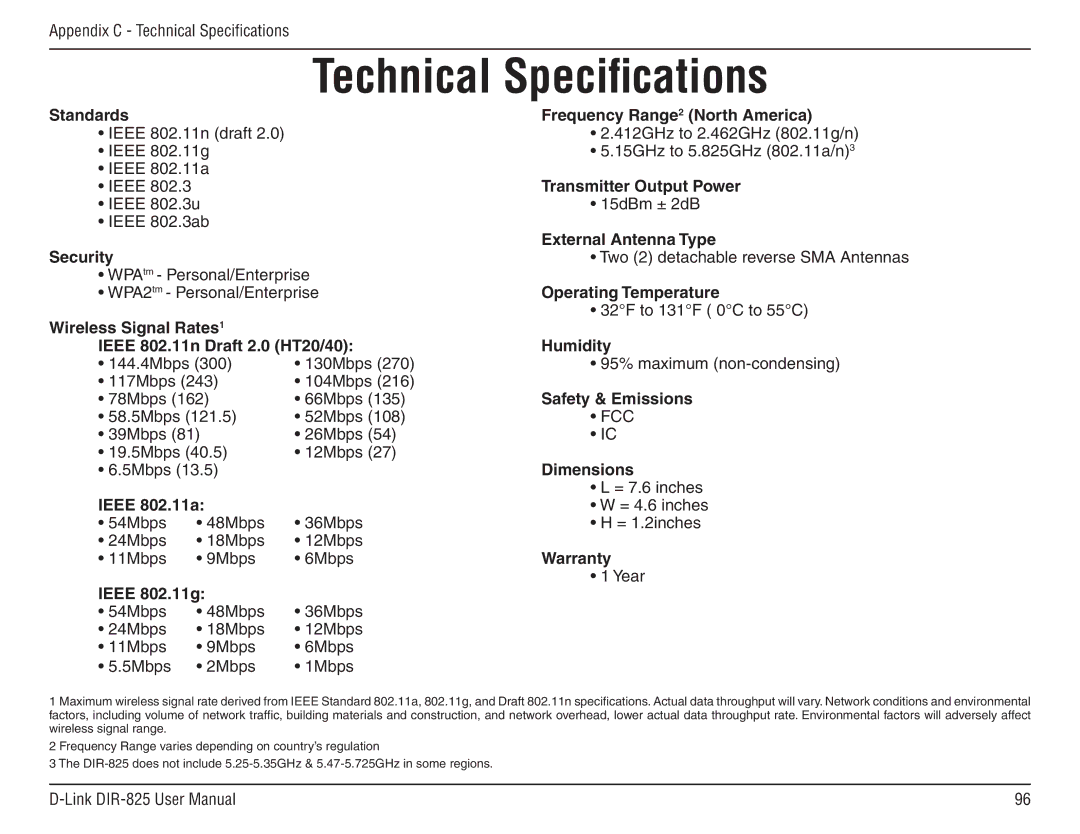Appendix C - Technical Specifications
|
|
| |
|
| Technical Specifications | |
Standards |
|
| Frequency Range2 (North America) |
• IEEE 802.11n (draft 2.0) |
| • 2.412GHz to 2.462GHz (802.11g/n) | |
• IEEE 802.11g |
| • 5.15GHz to 5.825GHz (802.11a/n)3 | |
• IEEE 802.11a |
| Transmitter Output Power | |
• IEEE 802.3 |
|
| |
• IEEE 802.3u |
| • 15dBm ± 2dB | |
• IEEE 802.3ab |
| External Antenna Type | |
Security |
|
| |
|
| • Two (2) detachable reverse SMA Antennas | |
• WPAtm - Personal/Enterprise | Operating Temperature | ||
• WPA2tm - Personal/Enterprise | |||
Wireless Signal Rates1 |
| • 32°F to 131°F ( 0°C to 55°C) | |
|
| ||
IEEE 802.11n Draft 2.0 (HT20/40): | Humidity | ||
• 144.4Mbps (300) | • 130Mbps (270) | • 95% maximum | |
• 117Mbps (243) | • 104Mbps (216) | Safety & Emissions | |
• 78Mbps (162) | • 66Mbps (135) | ||
• 58.5Mbps (121.5) | • 52Mbps (108) | • FCC | |
• 39Mbps (81) | • 26Mbps (54) | • IC | |
• 19.5Mbps (40.5) | • 12Mbps (27) | Dimensions | |
• 6.5Mbps (13.5) |
| ||
IEEE 802.11a: |
| • L = 7.6 inches | |
| • W = 4.6 inches | ||
• 54Mbps | • 48Mbps | • 36Mbps | • H = 1.2inches |
• 24Mbps | • 18Mbps | • 12Mbps | Warranty |
• 11Mbps | • 9Mbps | • 6Mbps | |
IEEE 802.11g: |
| • 1 Year | |
|
| ||
• 54Mbps | • 48Mbps | • 36Mbps |
|
• 24Mbps | • 18Mbps | • 12Mbps |
|
• 11Mbps | • 9Mbps | • 6Mbps |
|
• 5.5Mbps | • 2Mbps | • 1Mbps |
|
1Maximum wireless signal rate derived from IEEE Standard 802.11a, 802.11g, and Draft 802.11n specifications. Actual data throughput will vary. Network conditions and environmental factors, including volume of network traffic, building materials and construction, and network overhead, lower actual data throughput rate. Environmental factors will adversely affect wireless signal range.
2Frequency Range varies depending on country’s regulation
3The
96 |
